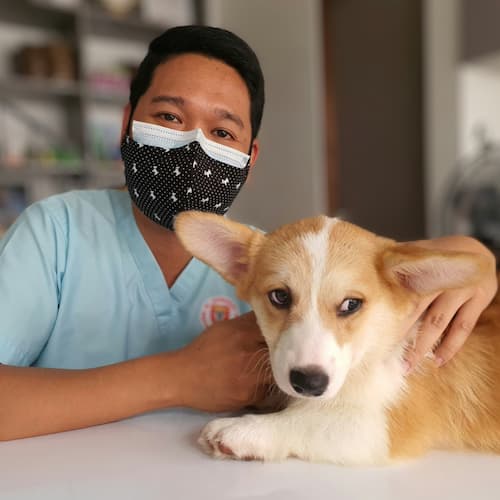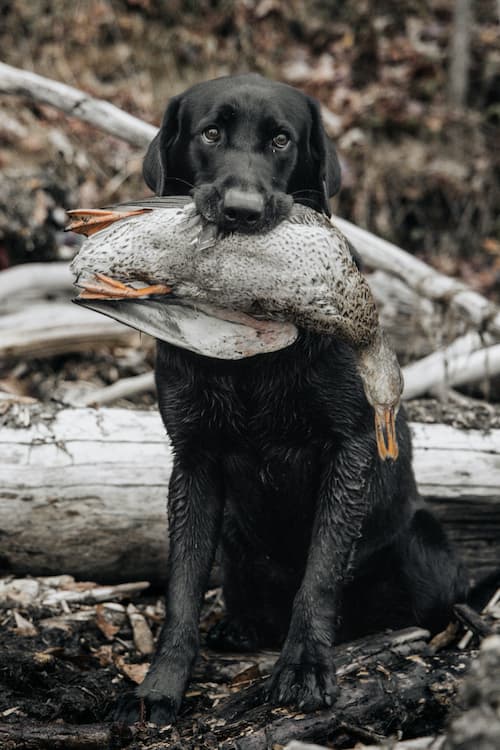
Pet owners

Veterinarians

Waterfowl hunters
There are two types of harmful algae that dog-owners should be aware of
1
Harmful algal blooms (also known as HABs, blue-green algae, and cyanobacteria)
2
Harmful algae mats (also known as benthic mats)
Both types of harmful algae can produce dangerous toxins that can cause serious illness or death in dogs. Learn how to identify the two types of harmful algae.
What will harmful algae do to my dog?
Harmful algae (or cyanobacteria) are microscopic organisms naturally present in reservoirs, lakes, rivers, streams, and wetlands. Animals are at high risk for getting sick from harmful algae and more likely to come in contact with or drink the water. Toxins produced by harmful algae can be fatal for dogs.
Animals are often exposed to harmful algae by:
Drinking contaminated water

Eating harmful algae mats

Licking harmful algae from their fur

If your dog comes into contact with harmful algae, rinse your dog with fresh water as soon as possible. Monitor for symptoms of harmful algae-associated illness in your dog.
Symptoms
These symptoms may differ depending on how and for how long your dog was exposed to harmful algae, and can include:
Direct skin contact or inhalation:
- Skin rash
- Skin hives
- Allergic reactions
Ingestion:
- Excessive drooling
- Vomiting
- Diarrhea
- Foaming at the mouth
- Stumbling
- Loss of appetite
- Difficulty breathing
Symptoms can appear minutes to days after harmful algae exposure. If an exposed dog displays symptoms, contact emergency veterinary care immediately.
If you believe your dog has been exposed to harmful algae:
- Wash your dog with clean water immediately
- Contact your veterinarian
- If your dog is displaying symptoms of harmful algae exposure, seek emergency veterinary care
You can also call ASPCA Animal Poison Control Center at (855) 764-7661 or Pet Poison Control Helpline at (801) 536-4123 for exposure-related questions. NOTE: there is often a $90-100 fee for these calls.
How do I know if a waterbody is safe for my dog?
You can check harmful algae waterbody advisories during recreational monitoring season. Even if there is no advisory for a particular waterbody, conditions can change rapidly, making it important for dog owners to learn how to identify harmful algae. Harmless filamentous green algae and duckweed are common in these environments, and may be mistaken for harmful algae–learn how to tell the difference between harmful algae and harmless aquatic vegetation.
If you suspect harmful algae may be present, keep dogs away from the water!
Do rapid water self-test kits work for detecting harmful algae?
Rapid kits or self-tests for harmful algae do not use methods approved by the U.S. EPA and may not accurately detect toxins. The best way to protect your dog is to know how to visually recognize harmful algae.
Veterinarians may interact directly with patients that have been exposed to harmful algae, or that have a harmful algae-associated illness. Harmful algae, also known as cyanobacteria or blue-green algae, are microscopic organisms naturally found in reservoirs, lakes, rivers, wetlands, and streams. Animals are highly susceptible to encountering harmful algae because they are attracted to the smell of harmful algae and more likely to come in contact with or drink the water. Learn more about harmful algae-associated illness symptoms, treatment, and testing resources.
Posters and handouts
Veterinarians may also find it helpful to display educational posters or distribute educational handouts in their clinics to inform animal owners of the risk of harmful algae to their pet. These materials may be printed by the veterinarian, or requested via Utah DWQ and DHHS by filling out this form.
Should I report harmful algae-associated illnesses?
Veterinarians should report suspected harmful algae-associated illnesses in any species as toxic substance contamination to the State Veterinarian’s Office at the Utah Department of Agriculture and Food (UDAF). To make a report, call (801) 982-2235 or fill out an online report.
For more information about identifying and reporting harmful algae-associated illnesses, veterinarians can access a brief fact sheet or a more detailed diagnostic toolkit. These materials–the factsheet and diagnostic toolkit–are also available as requested by the Utah Division of Water Quality.
Symptoms
Symptoms may vary widely depending on the type of toxins present and route of exposure. Animals may become sick within minutes to days.
Hepatotoxins and nephrotoxins:
- Excessive drooling
- Vomiting and diarrhea
- Hepatomegaly
Neurotoxins:
- Ataxia
- Difficulty breathing
- Seizures
Call the ASPCA Animal Poison Control Center at (888) 426-4435 or the Pet Poison Helpline at (855) 765-7661 for specific case consultation (there is typically a $90-100 fee for these calls).
For more information on symptoms, refer to the diagnostic toolkit for veterinarians.
What tests are available for confirming harmful algae-associated illness?
Cyanotoxin poisoning can be diagnosed based on clinical symptoms and a history of exposure. Therefore, while testing and/or necropsy may not always be necessary, it should be considered to rule out other causes of death or to confirm the presence of algae matter or contaminated water within the animal’s stomach.
You can submit the whole animal to the Utah Veterinary Diagnostic Laboratory (UVDL) for necropsy. Please contact them for more information on pricing and submission. Contact the Logan branch at (435) 797-1895 or uvdl@usu.edu, or the Central Utah branch at (801) 798-5435 or Jane.Kelly@usu.edu.
GI contents, serum, and/or urine can be tested for cyanotoxins. For more information on cyanotoxin testing, including laboratory information and specimen collection, refer to the diagnostic toolkit for veterinarians.
Additional resources for veterinarians
Educational Harmful Algae Poster
Educational Harmful Algae Handout
Harmful Algae Animal Exposure Fact Sheet for Veterinarians
Harmful Algae and Animal Exposure Diagnostic Toolkit for Veterinarians
There are two types of harmful algae that dog-owners should be aware of
1
Harmful algal blooms (also known as HABs, blue-green algae, and cyanobacteria)
2
Harmful algae mats (also known as benthic mats)
Both types of harmful algae can produce dangerous toxins that can cause serious illness or death in dogs. Learn how to identify the two types of harmful algae.
How can I keep my dog safe while waterfowl hunting?
Harmful algae can persist throughout the fall and winter, posing a threat to waterfowl hunters and their dogs.
Learn to recognize harmful algal blooms (HABs, blue-green algae, cyanobacteria) and harmful algae mats (benthic mats). They occur in standing water, flowing water, and wetlands. In wetland areas, such as those surrounding Farmington Bay, Ogden Bay, Willard Spur, or Utah Lake, harmful algae may be present in some areas and absent in others. The best way to keep safe while still enjoying waterbody access is to know what to look for and check before entering the water.
If harmful algae is present, hunters are advised to:
- Avoid contact with water or scum
- Clean waterfowl well
- Discard all waterfowl guts
- Keep dogs away from the water
If hunters suspect a bloom, it is especially important to keep dogs away from harmful algae, since the toxins produced by harmful algae can be fatal for animals. Learn how to keep a dog healthy while recreating near or in Utah waterbodies.
How do I know if there is harmful algae in an area?
During the recreating monitoring season (until October 31st each year), hunters can check harmful algae waterbody advisories. Even if there is no advisory for a particular waterbody, conditions can change rapidly, making it important for hunters to learn how to identify harmful algae. Filamentous green algae and duckweed are common in these environments, and may be mistaken for harmful algae–learn how to tell the difference between harmful algae and harmless aquatic plants.

